There are some occasions in life that leave an indelible mark in our lives. A wedding, a birth, a meeting – anything can get imprinted in one’s heart. When my dear friend Uma invited me over for the wedding of her son in Karaikudi, little did I know that it would be one such soul-stirring experience. Ask any Tamil about the grandeur of a Chettinad wedding, and his eyes will take on an immediate sparkle. As we would be staying there for the extended week end for the wedding, friends came up with a tour plan. The sites to be visited or deferred to the next trip were discussed, analysed, a time plan worked out, and all was set. Phew! That itself was tiring, though the eight-hour journey to Karaikudi by train in the night went smoothly.
The morning sunrise was splendid, so was the roadside chai we had at the famed ‘tea kadai bench’, as we women sat basking in the sun, drinking chai, reading the daily newspaper and chatting. The van arrived, loaded with breakfast. This hostess knew how to spoil her guests!
Avudaiyarkoil, the heritage town
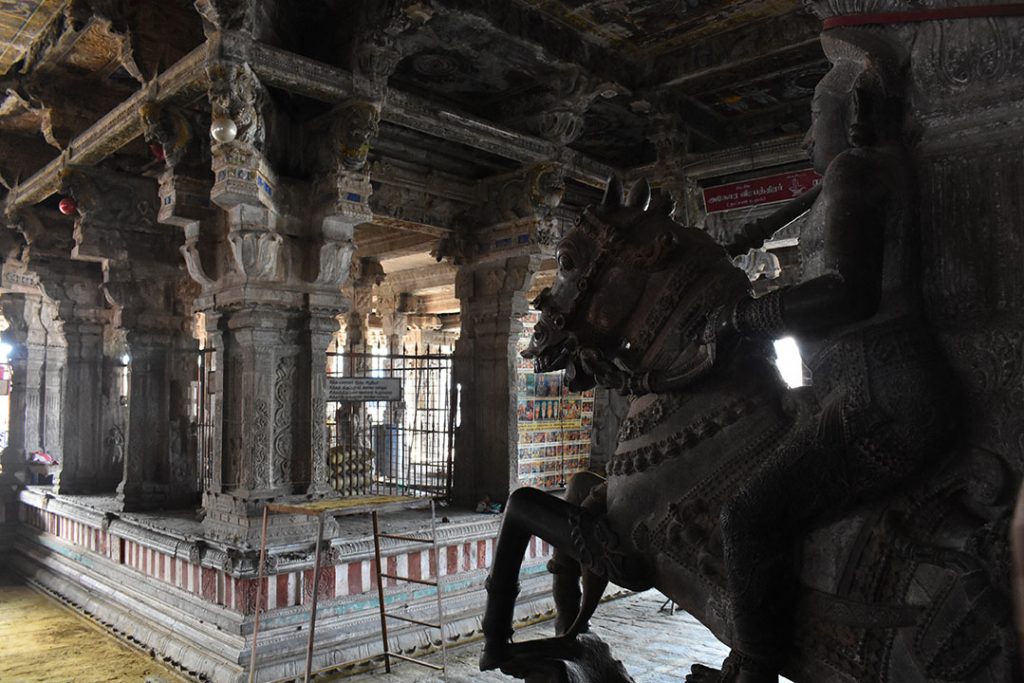
The first place we landed in was Avudaiyarkoil, the ‘heritage town’. The temple is also known as Avudaiyarkoil, the main deity being Athmanadhaswamy. As we entered the front pillared mandapam, we saw a set of fine pillars, in which are carved 1000 miniature pillars! It is very usual to see 1000 pillared mandapams in temples of the South, but this one was spell binding. As we walked in further, we could see huge sculptures of warriors seated on horses.
The temple has an interesting connect to horses. It is the famed Saivite Saint of the eighth century, Manikkavasagar, who built this temple. Manikkavasagar was a minister in Pandya King Arimarthana Pandiyan’s Court. The King had sent Manikkavasagar to buy horses for the army. Manikkavasagar saw his Guru under a tree at Thiruperun- durai, and overcome by his love for Shiva, built the magnif- icent Avudaiyarkoil temple with that money.
When the King asked for the horses, Manikkavasagar in his divine trance sent a message that the horses were on their way. Lord Shiva himself converted a pack of foxes to horses and rode majestically into the city of Madurai. The King was overwhelmed with joy at seeing the fine horses. But when night came, the ‘foxes’ started howling, and Manikkav- asagar was imprisoned!
You can still find here the original handwritten palm leaf manuscript of “Thiruvasakam” written by Manikkavasagar in the eighth century! As we went further in, we found the ceilings bedecked with beautiful mural paintings, like Madurai’s famed ‘Sungudi’ sarees with borders and pallu. A mandapam full of Nayak period paintings show the ‘Tiruvilaiyadal Puranam’- divine plays of Lord Shiva and the happenings in the life of Manikkavasagar. The Gandaberun- da – double headed eagle painted in the ceiling, its claws clutching an elephant, looked amazing. As we loitered around the inner prakarams of the temple, we saw the unique Navagrahas, sculpted on the tall pillars, three or four of them on each pillar. We moved out to the outer praharas and were amazed to see the stone chains hanging from the ceilings, the wafer thin chiseled sunshades carved out of fine stone. The zephyr roof work of this temple mandapam is simply unparalleled, so much that it is said the Britishers fired and bored holes through the roof to see how thin, yet sturdy the roof work was! We wondered at the Kurundha tree – the temple’s sthala-vruksha and moved on to our next stop, after devouring Chettinad’s famous fluffy idlis, vadas, onion chutney, sambhar and the red rice speciality – kavuniarisi!
The next stop was the Viruthapureeswarar Temple at Thirupunavasal. This Saivite temple has the largest linga, only next to Gangai Konda Cholapuram and Tanjore’s Brahadeeswara. The sight of the nine feet linga and the
82.5 feet Avudaiyar (the seat for placing the deity) around it, was just so ethereal! The temple itself is set very close to the sea – about three kilometres away, and near Pambar river. The Kaliyamman (female Mother Goddess) of this temple is so special, said to be in eternal anger that anyone praying to her must only see her through the tall mirror placed at the entrance of Her shrine. Outside the shrine are trees with bangles and small cradles hung all around, as offerings for children born or request to the Divine for a child.
A church called John De Britto

We continued our travel towards Oriyur John De Britto church. John De Britto, a missionary of Roman Catholic Church, came to India for spreading the word of God. He found Marava country – the areas to the South of Madurai ideal for his missionary work. However, the local king whom he had converted to Christianity by name Thadiya Thevar, sent back all his wives except one, as bigamy or polygamy was not allowed in Christianity, trouble started brewing. The Setupati King of Ramnad, whose niece was one among those sent back, reported to the Ramnad King of her ill-fate and then started the general persecution of Christians in that area. The King of Ramnad ordered the execution of Britto, We moved out to the outer praharas and were amazed to see the stone chains hanging fromwhich was carried out in Oriyur in 1693. Two centuries after his death, Britto was beatified by the Pope as a Saint. The sand atop the hill where he was murdered turned red, as his blood fell. A small church was constructed in Oriyur, in remembrance of the martyr, on the land donated by the later king, Vijaya Renganatha, in 1734. The beautiful Portuguese façade, buttresses holding the arches and circular dome at the center, makes this one of the most beautiful churches of the area.
A beautiful Chettinad Palace
Our van next travelled to the Chettinad Palace, a beautiful mansion built by Annamalai Chettiyar in Kanadukathan village. The impressive palace constructed in 1902 has three mithams or open thresholds, Burmese teak windows and doors, colourful athangudi tiles on the floor, and embellished with amazing furniture ranging from ornate ivory candleabras, to massive carved wooden columns. The dining hall is said to seat 250 people, and the kitchen has a long range of mud stoves for cooking. The adjoining bathroom has an inbuilt well to draw water. The courtyard is massive and so are the mirrors and corridors. The underground garage is another beauty, and so is the small balcony at the first floor, specially designed for the women of the house to enjoy some fresh air. We found a ‘kili josiyam’ expert – a fortune teller with parrot and hamster at the gates of the palace, and took turns listening to our fortunes being told, amidst peals of laughter.
A short visit to Sirukoodalpatti, the birth place of Tamil moviedom’s famed song writer Kannadasan, and the day was wrapped up. But wait! The fun wasn’t over yet. We went to the bridegroom’s house for dinner and chit-chat. Refreshed, we set out on Day 2, for sight-seeing. Our first stop was Piranmalai Kodunkundreeswarar Temple. This temple was once situated in the area ruled by one of the last seven kings of Sangam era – “Kadai ezhu vallal” Paari. Legend of King Paari goes this way – the king is said to have donated his chariot to a mullai (jasmine) plant which was longing for some support to grow! The flight of steps leading to the temple are splattered with fragments of inscriptions, and the temple on top is a rock-cut cave temple and Lord Mangaibagar resides there, holding the hands of his consort Thenammai. The ceiling of the cave is decorated with scenes from Tiruvilaiyadal – including the wedding of Lord Shiva and Parvati. The three-tiered edifice has a temple for Viswanathar and Visalakshi in the middle section, and the ground level is the temple of Kodunkundranathar. The bell atop the temple has astounding audibility, it is said the sound from it is heard even from miles away!
We gobbled up the idlis and sambhar and continued our journey to Kudumiyanmalai Temple. We were misled enroute, but it had a happy ending – we ended up bang at the doors of another beautiful rock-cut cave temple complex – Malaiyakovil. The hillock has two caves, one on the southern side- that houses Lord Okkaliswara and the eastern side houses Malaikolundeeswarar. The cave on the southern precipice is in a well designed mandapam, whereas the eastern cave is a cellar with rock-cut extension in the front. The period of construction of these temples can be roughly estimated to late Pandya period. Conjoining these two caves lies a beautiful tank with steps, but it is dry.
Of monkeys and bees!
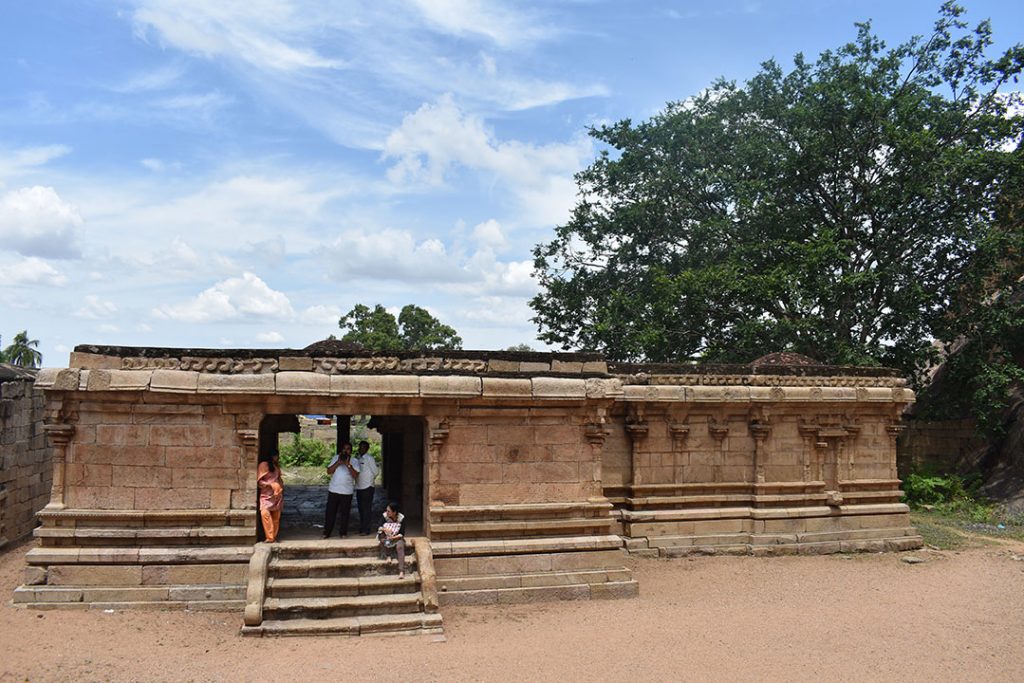
We rushed to our next stop – Kudumiyanmalai Temple. The moment we alighted from the van, we were surrounded by an army of monkeys. Shooing them away, we rushed inside, to have a quick glimpse of the Lord Siva, who is called “Shikanathar”, because of the unusual kudumi/shikha – a head bun! The earliest inscription of this temple is an interesting musical treatise in Pallava Grantha script belonging to the seventh century! As we made our way to the musical treatise inscription attributed to Pallava King Mahendra Varman I, which is inscribed on a hillock, we were scared away by a horde of bees. Bee hives adorn the inscription mandapam pillars. The main cave temple atop the hillock is said to have been constructed before the Cholas by Mutharaiyars, the vassals of Cholas and Pallavas. The maha mandapam has been built during the reign of Kulothunga Chola. The Soundaranayaki Amman shrine to the south of the cave was built by the danseuse Umaiyalvi Nachi, the Devadasi of Kudumiyanmalai, who bought the temple lands for 73,300 gold coins! There are almost 100 inscriptions in the temple, and it took all our might not to sit there reading the lines and relishing the puzzles hidden therein. We moved through the Raasi mandapam and the 1000 pillared mandapam, our eyes feasting on the sculp- tures. The life size sculptures of Rati and Manmadha in the outer mandapam are spellbinding!
Our next stop was Sithannavasal – the rock-cut Jain temple that is equivalent to Ajantha. The climb to the top of the hillock was as always arduous, and by the time we arrived at the top, tired and hungry, the sight of the beautiful mural paintings done with pure vegetable dyes on the ceilings of the small cave, offered solace to the eyes, the cool air inside the caves gave us respite from heat, and the soul wandered in silent prayer, as we entered the small sanctum.
The famed musical treatise inscription, Piranmalai
For over a thousand years the paintings have withstood time and weather in this dry part of the country. Five Thirthan- karas adorn the inner sanctum and the ‘Om’ sound given by the guide reverberated inside us. As we moved out to the mandapam, we literally opened our mouths wide, gazing at the marvel. A pond. Lotuses. Pairs of Andril birds. Colourful fishes. Gods plucking lotuses. The painting is said to recall the “Samavasarana” faith in Jainism. Though the period of construction is not known, there is an inscription attributing repairs to the cave temple complex during the period of early Pandya King Srivallabha during ninth century.
And then, a dargah
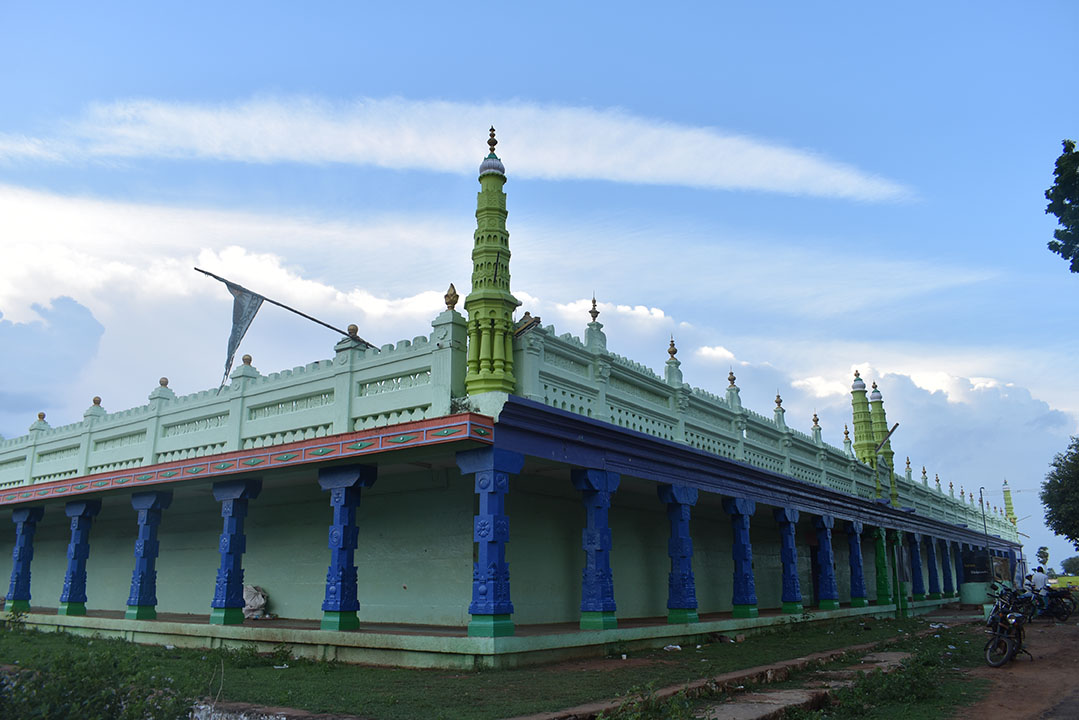
We returned to Karaikudi for a sumptuous lunch and relaxed, roaming around the humongous mansion of our hostess. A short break, and we hit the road again, this time to a beautiful dargah! The Kattu Bava Pallivasal was built about 500 years ago, in the traditional Dravidian kallu-palli style. It looks like any Hindu temple, with pillared mandapams and sanctum housing the deceased saints. In this dargah is entombed Bava Fakruddin, the grandson of Nagore’s saint Shahul Hameed. Classes were on, and we waved to the bunch of children deep in religious learning. As we moved out of the dargah, we were greeted by iridescence in the sky, a hundred colours scattered above us. We settled for a cup of chai on the steps of the nearby pond, wondering at the setting sun and iridescence flanking the dargah, quietly chatting.
The grand wedding
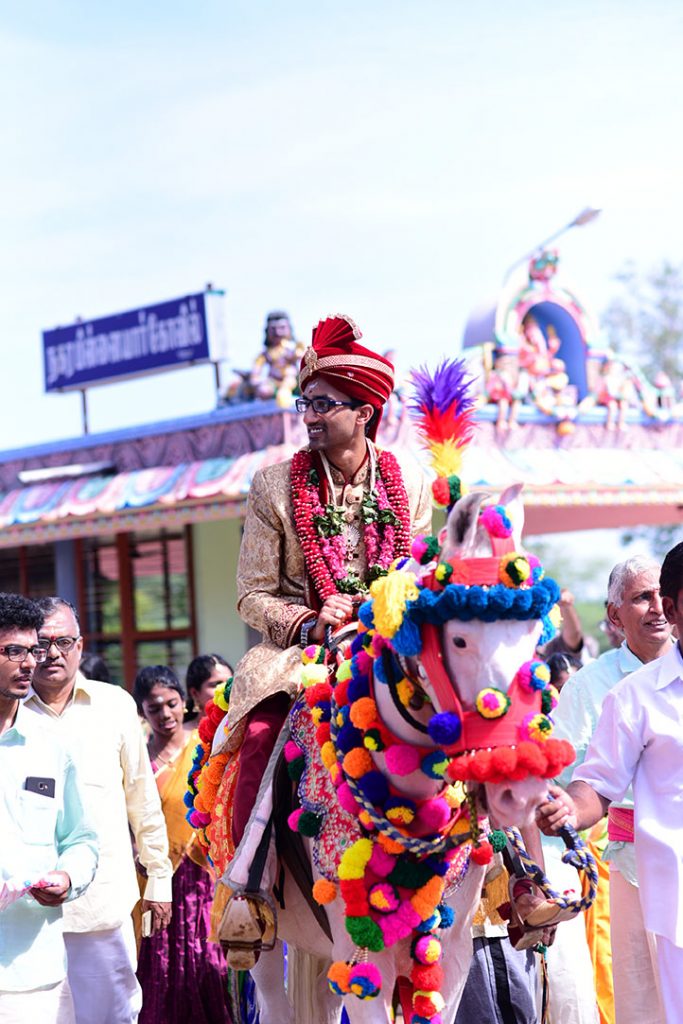
Our night was marked by merry making – the mehndi function and the kazhuthooru korthal. The kazhuthooru is the massive gold ornament the groom ties around the neck of the girl in Nagarathar (Chettiyar clan) weddings of Chettinad. It has 31 (three more pieces are added after consummation of marriage) pieces of gold strung on two twists of 21 strings, hand-coated with turmeric. Interestingly, the Nagarathar weddings are affairs at home, the men taking the lead in almost all the functions involved with the wedding. We watched the men of the house clad in white veshtis and shirts going in circles, twisting the yellow twine, and then the chief jeweler sitting down to place them togeth- er and compile the kazhuthooru. The line for mehndi was longer than the Great Wall of China, and so we made our escape from the mansion soon, to catch some beauty sleep. The next day was the grand wedding, and we didn’t want to look tired and haggard.
We freshened up in the morning, and after a heavy dose of makeup, jewelry and in Kanjeevaram saris, made our way to the groom’s house. The cavalcade left soon for the bride’s house, which was about 40 km away, and we joined the party. We were seated in a separate ladies dining hall in a huge house and after devouring the breakfast feast, we left for the temple where the groom’s family waited before starting the ‘groom’s procession’. After prayers, the party started the procession, with the groom hoisted atop a horse which was bedecked with colorful pompoms. Crackers shook the town, the crowd shook a leg, and we entered the bride’s house with much pomp and show.
The wedding ceremony began, a simple ceremony at home, but again, segregated halls for men and women with air-conditioners blasting cool air. The Nagarthars tie three thaalis (mangalsutras) – a simple one in gold for regular use, a diamond thaali for formal occasions, and the kazhuthooru. Once the thaali is tied, the couple fall at the feet of the elders for their blessings. The women and men clamber up a narrow staircase to ‘see’ the array of gifts on display, being exchanged between both the bride and groom, given by their respective families. Lunch time, and we feel gluttonous, and relish the heavy meal.
On the way back to Karaikudi, we had arranged to see a private collector’s house which he had turned into a beautiful museum of interesting artefacts. G.R. Mahadevan is a passionate collector of toys and various knick-knacks, and his house is a living museum. Not an inch of the lovely bungalow is left free, the kitchen to the bathrooms to the balcony – all house amazing displays of antiques. Biscuit boxes, tin toys belonging to the 1940s, magazines, cigarette boxes, wine bottles, calendars, tin chocolate boxes, prams, radios, dozens of cameras, lanterns, kerosene stoves, tens of old phones, cooker of 1930s, oven of 1950s, vintage posters of actresses, movie posters, ice-cream maker of the 50s, the man has anything and everything. Heavens, he even has a maattu vandi (cow cart) of yesteryears parked in his lawn. The house can take you to altogether another world when you enter. I was already feeling like Alice in Wonderland, jumping from room to room, admiring the antiques and getting chided gently by the group for my childish anxiety.
We took leave, reached our rooms and geared up for the grand dinner hosted by the groom’s family. We accompanied the couple on a nagar valam – a procession along the streets of the town, reached the groom’s house and feasted again. The last couple of days had been a kind of eat-a-thon! With heavy hearts we took leave and packed for our return journey. As the train chugged through the dark night, all I could wonder was, “Dear God…when is the next trip?”

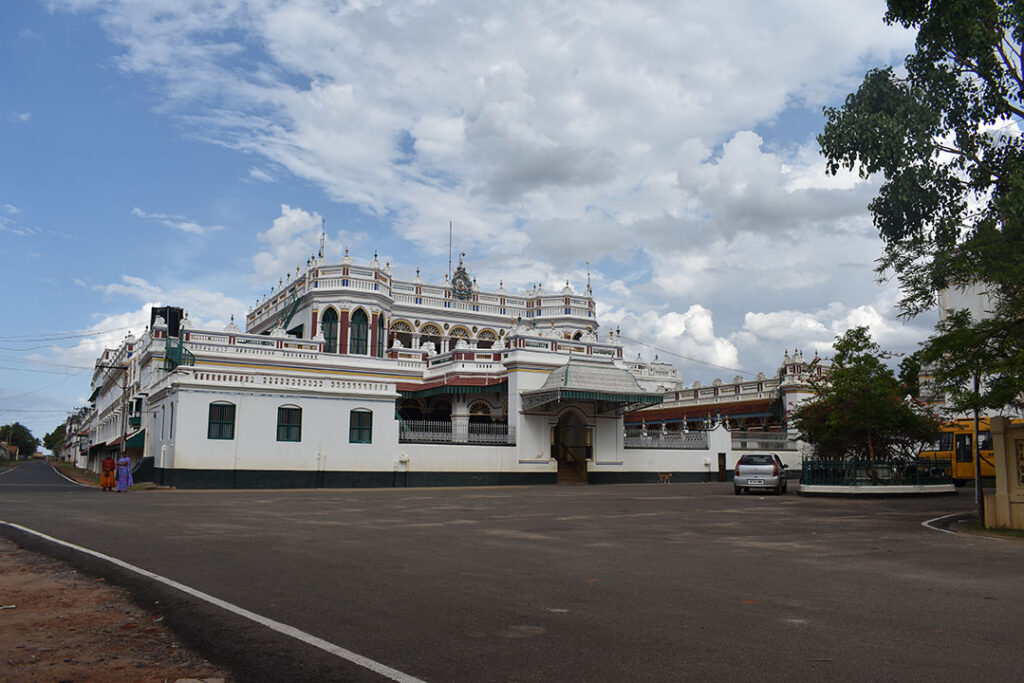
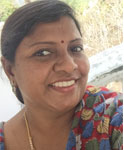 [/column]
[/column]